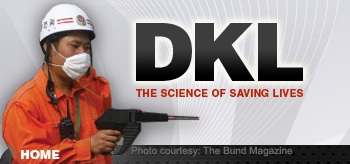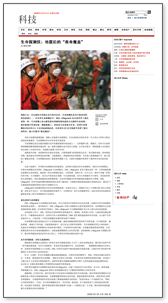







The Bund Magazine
(Translation of original article at right)
The DKL LifeGuard is one of the most important pieces of scientific equipment used to search for survivors buried in rubble. Among the many different kinds of life detection equipment, the DKL LifeGuard is the most advanced. It searches for the Ultra Low Frequency electronic field generated by a human heart to detect vital signs. It can penetrate ruins, rubble, steel, cement buildings, bricks, and even water to detect survivors.
This vital sign detection technology matured rapidly after 9-11. After the May 12, 2008, Wenchuang earthquake, the DKL LifeGuard proved to be extremely useful. People called it the “Magic Box of Lifesaving”.
At the earthquake site, rescuers used DKL LifeGuard units to look for lucky survivors in the rubble. The DKL LifeGuard could detect the vital signs of the survivors, even when they could not be seen or heard by rescuers, and in an open space, the DKL LifeGuard can detect vital signs at ranges greater than 500 meters.
The DKL LifeGuard, together with remote sensing aircraft, search and rescue dogs, and highly efficient clean-up compression tools, were called the four weapons of the rescue effort. Using the four tools together, rescuers found survivors under the rubble for up to 200 hours after the earthquake.
Right after the earthquakes occurred, the surface conditions were unusually complicated and dangerous. The radar imagery from the remote sensing aircraft was the most helpful in assessing the situation on the ground. Once the situation was stable and the clean up could begin, saving human life became the most urgent task, and the DKL LifeGuard became the most important rescue tool. It could sense vital signs without direct contact with human body.
In the Wenchuang earthquake, four different kinds of life detectors were used at the same time: optical, infrared, sonic, and the DKL LifeGuard.
The DKL LifeGuard proved to be the most advanced. It senses the ultra low frequency vital signs generated by the heart, and compared to the other three, the DKL LifeGuard is light and easy to handle. It weighs about only one kilogram, can be hand-held, and is easy to control and durable. It can be connected to a computer, or it can be used independently. The other kinds of life detectors all have to be connected to corresponding peripherals, such as a computer for data analysis or an electronic screen. The DKL LifeGuard is the best in locating vital signs and the most accurate way to locate the of source the vital signals. It responds to the ultra low electric frequency directly and points to the source of the field.
DKL uses the characters of dielectric material to detect an electric field. According to the research department of DKL, the beating heart generates a non-uniform, Ultra Low Frequency electric field for 360 degrees around the human body. The heart is the center of this electric field.
The most advanced part of the DKL LifeGuard is its electrical filtering, which enables it to detect only the human heart’s unique electric field. It detects only electrical fields that are at or below 30 Hz, the low frequency that is characteristic of human bodies, the human electric field polarizes the special dielectric material of the DKL LifeGuard, and the LifeGuard points to the strongest part of the non-uniform electric field, which is the heart. This technology enables the DKL LifeGuard to accurately identify humans who are still alive during a rescue, without distracting information from other animals.
DKL International successfully developed the LifeGuard detector during the last century. The development of DKL rescue equipment matured rapidly after 9-11, and DKL now utilizes the most advanced technology in biochemistry, dielectrics, ultra low frequency and DNA to improve its functions.
The company not only does research in the area of detecting and locating vital signals, but also does research on the human electric field. This research allows the DKL LifeGuard to respond to the human electric field quickly and directly, and this has helped response teams to become more efficient during the later stages of search and rescue.
The end result of all this development is the DKL LifeGuard. It is in use in the security business, and in Japan.
Courtesy of The Bund magazine
